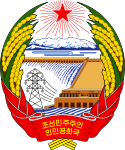
Back فترة كيم (كوريا الشمالية) Arabic Династия Ким (Северна Корея) Bulgarian Kim-Dynastie (Nordkorea) German Δυναστεία των Κιμ (Βόρεια Κορέα) Greek Dinastía Kim Spanish سلسله کیم Persian Dynastie Kim French משפחת קים HE Kim-dinasztia Hungarian Dinasti Kim (Korea Utara) ID
| Kim family Mount Paektu bloodline | |
|---|---|
 | |
| Parent family | Jeonju Kim clan |
| Country | North Korea |
| Place of origin | Mangyongdae, Pyongyang |
| Founded | 9 September 1948 |
| Founder | Kim Il Sung |
| Current head | Kim Jong Un |
| Titles | Supreme Leader of North Korea General Secretary of the Workers' Party of Korea |
| Style(s) |
|
| Members | |
| Connected members | Kim Il Sung's wives: Kim Il Sung's sons: Kim Il Sung's daughters: Kim Jong Il's wives: Kim Jong Il's sons: Kim Jong Il's daughters: |
| Traditions | Juche |
| Estate(s) | Residences of North Korean leaders |
| (Mount) Paektu bloodline | |
| Chosŏn'gŭl | |
|---|---|
| Hancha | |
| Revised Romanization | Baekdu-hyeoltong |
| McCune–Reischauer | Paektu-hyŏlt'ong |
 |
|---|
|
|
The Kim family, also known as the Kim dynasty or the Mount Paektu bloodline in the ideological discourse of the Workers' Party of Korea (WPK), is a three-generation lineage of North Korean leadership, descending from the country's founder and first leader, Kim Il Sung. The patriarch came to rule the north in 1948, after the end of Japanese rule split the region in 1945. He began the Korean War in 1950, in a failed attempt to reunify the Korean Peninsula. In the 1980s, Kim Il Sung developed a cult of personality closely tied to the North Korean state philosophy of Juche. Following his death in 1994, Kim Il Sung's role as supreme leader was passed on to his son Kim Jong Il, and then to his grandson Kim Jong Un. All three men have served as leaders of the WPK and have exercised absolute control over North Korea since the state's establishment in 1948.
The North Korean government denies that there is a personality cult surrounding the Kim family, describing the people's devotion to the family as a personal manifestation of support for their nation's leadership.[1] The Kim family has been described as a de facto absolute monarchy[2][3][4] or hereditary dictatorship.[5]
- ^ Jason LaBouyer "When friends become enemies — Understanding left-wing hostility to the DPRK" Lodestar. May/June 2005: pp. 7–9. Korea-DPR.com. Retrieved 18 December 2007.
- ^ Young W. Kihl, Hong Nack Kim. North Korea: The Politics of Regime Survival. Armonk, New York: M. E. Sharpe, Inc., 2006. p. 56.
- ^ Robert A. Scalapino, Chong-Sik Lee. The Society. University of California Press, 1972. p. 689.
- ^ Bong Youn Choy. A history of the Korean reunification movement: its issues and prospects. Research Committee on Korean Reunification, Institute of International Studies, Bradley University, 1984. Pp. 117.
- ^ Moghaddam, Fathali M. (2018). "The Shark and the Octopus: Two Revolutionary Styles". In Wagoner, Brady; Moghaddam, Fathali M.; Valsiner, Jaan (eds.). The Psychology of Radical Social Change: From Rage to Revolution. Cambridge: Cambridge University Press. p. 285. ISBN 978-1-108-38200-7.
© MMXXIII Rich X Search. We shall prevail. All rights reserved. Rich X Search